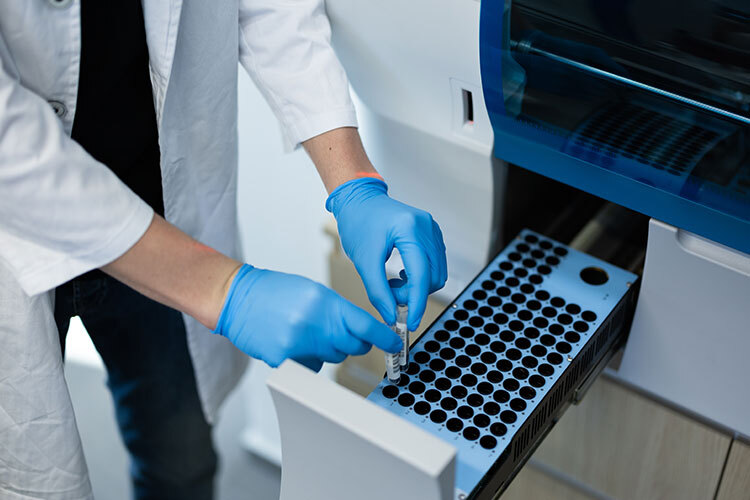The development of molecular-level sensors for early detection of lung cancer through blood serum, prior to severe symptoms of the disease, could potentially address this health issue, which proves fatal for many patients.
SytoSol, a spin-off from the scientific and technological entrepreneurship ecosystem at Tec de Monterrey, focuses on advancing healthcare technologies. Their innovations target the next generation of sensors to enhance diagnostic techniques and enable early disease detection with greater precision.
Currently, SytoSol is actively developing products aimed primarily at two conditions: lung cancer and glaucoma.
Lung cancer is often diagnosed in advanced stages in nearly 80% of patients, with only 30% surviving five years post-diagnosis. Meanwhile, glaucoma, characterized by increased eye pressure, affects over 75 million people worldwide, yet half may be unaware of their condition. Delayed treatment can result in complete vision loss for up to 10% of those affected.
“Our mission is timely detection to facilitate the development of more effective and less invasive therapies for patients,” said Sergio Martínez, researcher and leader at Tec’s scientific and technological entrepreneurship company.
How do These Biomolecular Sensor Platforms Work?
SytoSol is currently developing two biomolecular sensor platforms: SytoSol VEGF, for detecting retinal ischemia, and SytoSol Cyfra 21-1, for diagnosing lung cancer.
“These sensors are non-invasive, operating externally from the human body; they require a sample of biological fluid such as blood or serum. They are composed of a material developed here at Tec de Monterrey,” Martínez explained.
Regarding lung cancer detection, SytoSol is creating a device intended as an alternative to techniques like low-dose X-ray computed tomography. Martinez said these radiographs as “not timely” because they often detect the disease only in advanced stages and are inaccessible due to high costs.
This sensor operates using a blood serum sample to identify the presence of a biomarker called Cyfra 21-1, even in low concentrations, indicating early disease development.
“Under these conditions, physicians can administer more effective treatments to help patients manage cancer progression,” Martínez noted.
Detecting Glaucoma
SytoSol’s second application focuses on measuring VEGF (Vascular Endothelial Growth Factor) protein concentration, which signals blood vessel growth in the ocular globe.
Patients diagnosed with diabetes, particularly, may experience insufficient oxygen in the ocular globe, prompting the body to produce VEGF, resulting in excessive eye growth and potential vision loss.
“Currently, there isn’t a simple technique for ophthalmologists to measure this protein in their office. With such a tool, proactive measures like medication to inhibit blood vessel growth could be implemented,” added Martínez.
Technology for Biomarker Measurement, Even at Low Concentrations
SytoSol employs electrochemical sensors to detect established biomarkers for each condition, capable of identifying various markers. These miniature sensors consist of electrodes (SytoSol EC), comprising small metallic structures where electrical signals are inserted and extracted for concentration measurement.
“These electrodes undergo a process called functionalization to modify their surfaces, crucial for differentiating the biomarker we aim to detect,” Martínez elaborated.
Designed and developed by researchers at Tec de Monterrey, these electrodes have two patents on their manufacturing process and are capable of detecting minute concentrations of biomarkers, facilitating the early detection of diseases when treatments can be more effective.
Additionally, these electrodes are constructed using carbon substrates (SytoSol SERS) and micro-manufactured gold nanoparticles, derived from a patented high-temperature pyrolysis process.
SytoSol’s Journey in Healthcare
In 2021, the global biosensor market was valued at over $25 billion, with an anticipated annual growth rate nearing 8% over the next decade.
Currently seeking investors to advance biosensor prototyping, SytoSol aims to secure $400,000 in funding. Their Technology Readiness Level (TRL 3) involves laboratory parameter measurement, with near-term objectives of developing functional biosensor prototypes by late 2025 and progressing towards clinical validation and regulatory testing by 2027.
“We’re focused on enhancing the robustness of these sensors, simulating and evaluating them under hospital-like conditions. Subsequently, clinical trials with real patient samples are crucial,” Martínez affirmed.
Furthermore, SytoSol’s team aims to refine and develop platforms for user-friendly applications as portable devices in medical practices.
Name: SytoSol
Field: Healthcare Technology
Technology: Electrode Materials
Innovation: Gold Nanoparticle Substrates
Market: Healthcare providers, researchers, pharmaceutical, and biotechnological industries.
Investment Need: $400,000
Objectives: Functional biosensor prototypes by 2025; clinical validation and regulatory testing by 2027.
Interested in this story? Want to publish it? Contact our content editor to learn more: marianaleonm@tec.mx.















